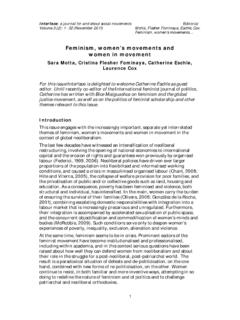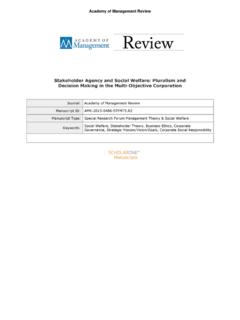Transcription of Feminist Theory - UC Santa Barbara
1 Theory DOI: 2005; 6; 115 Feminist TheoryClare Hemmings Telling Feminist The online version of this article can be found at: Published by: can be found at: Feminist Theory Additional services and information for Email Alerts: Subscriptions: : : Citations at UNIV CALIFORNIA Santa Barbara on April 19, 2009 from 115 Telling Feminist storiesTFClare HemmingsLondon School of EconomicsFeminist TheoryCopyright 2005 SAGE Publications (London, Thousand Oaks,CA and New Delhi) vol. 6(2): 115 139. 1464 7001 DOI: article identifies and analyses the dominant stories thatacademics tell about the development of Western second wave feministtheory. Through an examination of recent production ofinterdisciplinary Feminist and cultural Theory journals, I suggest thatdespite a rhetorical insistence on multiple feminisms, Western feministtrajectories emerge as startlingly singular.
2 In particular, I am critical ofan insistent narrative that sees the development of Feminist thought as arelentless march of progress or loss. This dominant approachoversimplifies the complex history of Western feminisms, fixes writersand perspectives within a particular decade, and repeatedly (anderroneously) positions poststructuralist feminists as the first tochallenge the category woman as the subject and object of feministknowledge. Rather than provide a corrective history of Western feministtheory, the article interrogates the techniques through which thisdominant story is secured, despite the fact that we ( Feminist theorists)know better. My focus, therefore, is on citation patterns, discursiveframings and some of their textual, theoretical and political effects.
3 Asan alternative, I suggest a realignment of key theorists purported toprovide a critical break in Feminist Theory with their Feminist citationaltraces, to force a concomitant re-imagining of our historical legacy andour place within , postmodernism, progress, the seventies, WesternfeminismIntroductionHow does Western Feminist Theory tell the story of its own recent past?Despite Feminist Theory s clear variety, both within and outside the West ,when telling its own recent story a dominant narrative, albeit one with arange of affective or critical inflections, does emerge. That story divides therecent past into clear decades to provide a narrative of relentless progressor loss, proliferation or homogenization.
4 Western Feminist Theory tells itsown story as a developmental narrative, where we move from a preoccu-pation with unity and sameness, through identity and diversity, and on to01_053690_Hemmings (JB-D) 15/6/05 2:43 pm Page 115 at UNIV CALIFORNIA Santa Barbara on April 19, 2009 from difference and fragmentation. These shifts are broadly conceived of ascorresponding to the decades of the 1970s, 1980s and 1990s respectively,and to a move from liberal, socialist and radical Feminist thought to post-modern gender Theory . A shift from the na ve, essentialist seventies,through the black Feminist critiques and sex wars of the eighties, and intothe difference nineties and beyond, charts the story as one of progressbeyond falsely boundaried categories and identities.
5 A shift from the politi-cized, unified early second wave, through an entry into the academy in theeighties, and thence a fragmentation into multiple feminisms and indi-vidual careers, charts the story as one of lossof commitment to social andpolitical theoretical approaches are characterized asbelonging to the 2000s is largely dependent on which version of this storyone aligns oneself with. When the story is a celebration of difference, weare commonly invited to (re)turn to affect as a source of individual andcollective knowledge. When the story is one marked by grief, the contem-porary call is instead for a return to the material contexts of women s , however inflected, the chronology remains the same, the decades over-burdened yet curiously flattened, and poststructuralism animated as thekey actor in challenging woman as the ground for Feminist politics andknowledge take issue with this double story for a number of reasons.
6 Firstly, itoversimplifies different areas of Feminist thought and the contests overmeaning that characterize Feminist debate at all points of its history. Inparticular, and as I explore further in this article, it either fixes racial andsexual critique of feminism as decade-specific, as a necessary but tempor-ary stage in the movement towards a more generalized notion of difference,or it places the blame for Feminist Theory s ills singularly at the house ofthe already beleaguered Feminist academic. Neither tack can be satisfac-tory, surely. Secondly, within this story, Feminist poststructuralist theoristsare repeatedly positioned as the first to deconstruct woman , and as eitherheroic in surpassing past mistakes, or responsible for the ills of feminismin general.
7 I dispute this characterization of poststructuralism for thesimple reason that one of the abiding concerns for the majority of feministtheorists has always been, and remains, such a ,this story has rightly been critiqued as an Anglo-American trajectorywithin Western Feminist thought, one that forces European or non-Westernfeminist theorists either to reposition themselves in line with the former slogic, or to depict themselves as critical or transcendent, but neverthelessas , then, this double story needs to be more carefully character-ized, not simply as Western but as Anglo-American. I wonder, though, ifsuch a move fails to do justice to the story s pervasiveness. Nationalnaming of this kind gives the mistaken impression that the problem ispredominantly one of exclusion, that what is needed to correct the story isclear more non-Western and Continental European discussion andreframing.
8 And this is certainly the case. Yet Continental Feminist theorynot only differentiates itself from this Anglo-American narrative ofprogress or loss, but also actively, if inadvertently, reconstitutes it. So, for116 Feminist Theory 6(2)01_053690_Hemmings (JB-D) 15/6/05 2:43 pm Page 116 at UNIV CALIFORNIA Santa Barbara on April 19, 2009 from example, in Italian Feminist Theory and Practice(Parati and West, 2002),a volume that challenges the dominance of French and Anglo-US feministtheory in the last three decades, the story of what has gone before is stillreiterated as comprising a familiar move from sex to gender, or from essen-tialism to deconstruction. The (Italian) future may be different, but the(Anglo-American) Feminist past remains the same.
9 As Domna Stanton andRosi Braidotti both warn us, the dominance of this story thus not onlystifles the particularities of different trajectories, but also sidelines themultiple differences within both Anglo-American and Continentalfeminist thought in the process (Stanton, 1985; Braidotti, 1997). Non-Western perspectives are also not absent from the dominant story feministtheory tells about its recent past. In fact, and as I explore below, the absorp-tion of the work of non-Western identified theorists such as ChandraMohanty (1988), Trinh T. Minh-Ha (1989) and Uma Narayan (1997) into aWestern trajectory can easily function as a further indication of thattrajectory s advancement. Finally, this story circulates so widely that fixingits origins as Anglo-American never quite captures the transitions andtranslations across English and non-English speaking Feminist contextsthat mark its progress.
10 So for now I want to stick with Western , aware ofthe omissions the term at once generates and ,ofcourse, ,formyownpart,despitethefactthatIfindmyo wnreadingoftherecentfeministpastatoddswi ththisstory, ,then, on how this dominant story is secured through our publishing andteaching practices despite the factthat we know it obscures the complex-ities we cherish. Which parts of this story are so consistently reproducedthat they are understood to speak for themselves without further elabora-tion? How is a dominant narrative of a shift from 1970s sameness, through1980s identity, to 1990s difference within Western English speakingfeminist Theory textually and rhetorically secured? What discursive andpolitical work does this narrative do, in terms of authenticating a particu-lar Feminist school or subject, or privileging a particular intellectualbiography or national location?







